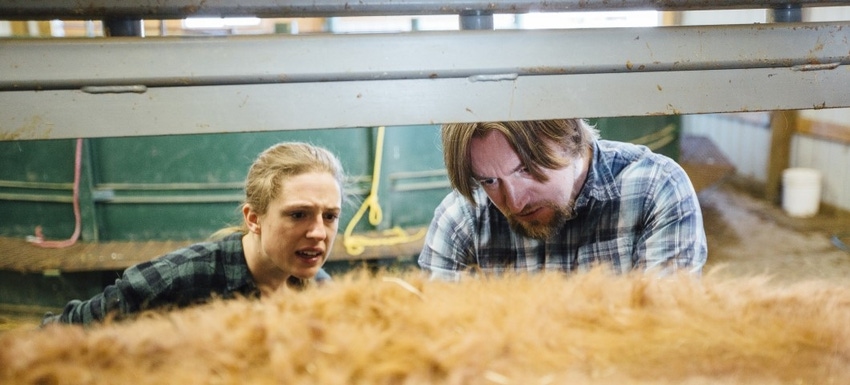Large portion of microbes that colonize bovine gut were derived from contact with mother.
June 26, 2018

A Montana State University faculty member has found that, like most good things in life, a majority of healthy microbes in newborn calves come from their mothers.
Carl Yeoman, associate professor in the department of animal and range sciences in the Montana State College of Agriculture, recently published findings in Scientific Reports, a publication of the science journal Nature. Yeoman said the paper is the first to demonstrate the maternal influence on calves’ earliest gut microbes, primarily where they come from and how they assemble in differing regions of the gut.
Yeoman, who researches and teaches about the microbial ecosystems in various animals, including cattle and sheep, said the paper is part of a five-year research project he began when he joined the faculty at Montana State. He added that its findings “have the potential to contribute greatly to the field of animal health and production.”
“Gut microbes, particularly the earliest gut microbes of livestock and other mammals, play important roles in animal health, including aiding the maturation of the animals’ immune systems and sustaining nutrition,” Yeoman said. “Understanding the routes of transmission of these important gut inhabitants allow us to influence their dissemination to future generations and provides motivation to protect these maternal microbial reservoirs.”
In the paper, Yeoman and his co-authors describe finding that a large portion of microbes that colonize the bovine gut were derived from contact with the mother — both during and after birth.
Additional authors on the paper include Suzanne Ishaq, a former postdoctoral fellow in Yeoman's lab who is now a research assistant professor at the University of Oregon; Elena Bichi from the department of animal sciences at the University of Leon in Spain; Sarah Olivo, research assistant at Montana State; James Lowe, director of the i-Learning Center and section head for integrated food animal management systems at the College of Veterinary Medicine at the University of Illinois Urbana-Champaign, and Brian Aldridge, professor of veterinary clinical medicine at the University of Illinois at Urbana-Champaign.
By examining microbes present in 10 regions of a calf’s gastrointestinal tract during the first 21 days of its life, the study showed that many important microbes are transferred to the calf from three unique maternal reservoirs, the announcement said.
“We show that, on average, 41% of microbes in gut mucosa (surface) and 46% in the gut lumen (gut contents) of calves are acquired from their mother’s vagina, colostrum and the skin around the udder,” Yeoman said. “The udder, in particular, had more influence than we expected.”
The gut mucosa is the body's largest immunological environment. Colostrum is the first form of milk produced by mammals immediately after giving birth.
Microbes such as methanogenic archaea -- which remove inhibitors of dietary fiber breakdown but, in so doing, produce the potent greenhouse gas methane -- were also found to be uniquely acquired from the mother cow’s vagina, he said.
According to Yeoman, almost all studies to date have focused on microbes of the rumen, but he and his fellow researchers believe there are more “good” microbes to discover elsewhere in a cow.
“We show that the microbes in the rumen are very different from those in other parts of the gastrointestinal tract, and there is good reason to think microbes in other parts of the gut are also important to nutrition as well as health,” he said.
Yeoman published similar results to the cow study about lambs in the Journal of Animal Science last year. Those findings show that microbes vary through differing regions of the lamb’s gut and that fiber-degrading bacteria exist both in the rumen as well as the colon, the university said. Yeoman said these microbes, along with other health-promoting bacteria in the small intestine, were all found to be important to feed efficiency of the animal.
Both findings pave the way for a better understanding of how to optimize livestock gut microbiota during the early stages of life, Yeoman said, which could lead to healthier and more productive livestock.
“Dr. Yeoman is using cutting-edge microbiological science to find answers to some of agriculture’s big problems,” said Patrick Hatfield, head of Montana State’s department of animal and range sciences. “The overall health of an animal, its ability to reproduce and how well it can fight off disease happens on the molecular level. His research is providing the agricultural industry with insight into the earliest interactions of an animal that has a lifelong impact.”
“There are a lot of unseen interaction that you can only pick up through molecular tools,” Yeoman said. “The way microbes interact with the animal host and with each other occur at the molecular level. Understanding these interactions is critical for the success of animal and the producer’s ability to be economically and ecologically sustainable.”
You May Also Like


.png?width=300&auto=webp&quality=80&disable=upscale)
